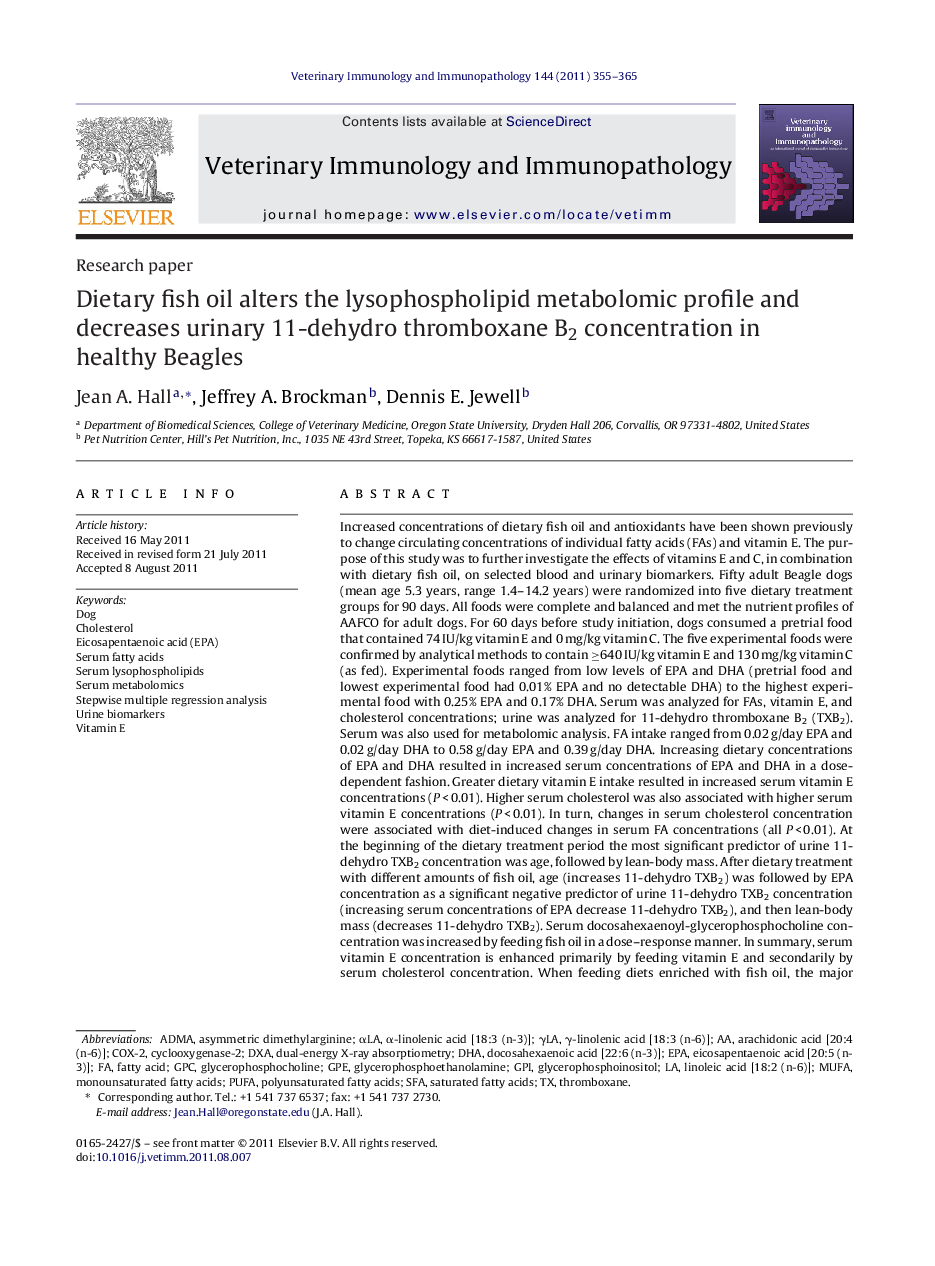| کد مقاله | کد نشریه | سال انتشار | مقاله انگلیسی | نسخه تمام متن |
|---|---|---|---|---|
| 2462014 | 1555062 | 2011 | 11 صفحه PDF | دانلود رایگان |

Increased concentrations of dietary fish oil and antioxidants have been shown previously to change circulating concentrations of individual fatty acids (FAs) and vitamin E. The purpose of this study was to further investigate the effects of vitamins E and C, in combination with dietary fish oil, on selected blood and urinary biomarkers. Fifty adult Beagle dogs (mean age 5.3 years, range 1.4–14.2 years) were randomized into five dietary treatment groups for 90 days. All foods were complete and balanced and met the nutrient profiles of AAFCO for adult dogs. For 60 days before study initiation, dogs consumed a pretrial food that contained 74 IU/kg vitamin E and 0 mg/kg vitamin C. The five experimental foods were confirmed by analytical methods to contain ≥640 IU/kg vitamin E and 130 mg/kg vitamin C (as fed). Experimental foods ranged from low levels of EPA and DHA (pretrial food and lowest experimental food had 0.01% EPA and no detectable DHA) to the highest experimental food with 0.25% EPA and 0.17% DHA. Serum was analyzed for FAs, vitamin E, and cholesterol concentrations; urine was analyzed for 11-dehydro thromboxane B2 (TXB2). Serum was also used for metabolomic analysis. FA intake ranged from 0.02 g/day EPA and 0.02 g/day DHA to 0.58 g/day EPA and 0.39 g/day DHA. Increasing dietary concentrations of EPA and DHA resulted in increased serum concentrations of EPA and DHA in a dose-dependent fashion. Greater dietary vitamin E intake resulted in increased serum vitamin E concentrations (P < 0.01). Higher serum cholesterol was also associated with higher serum vitamin E concentrations (P < 0.01). In turn, changes in serum cholesterol concentration were associated with diet-induced changes in serum FA concentrations (all P < 0.01). At the beginning of the dietary treatment period the most significant predictor of urine 11-dehydro TXB2 concentration was age, followed by lean-body mass. After dietary treatment with different amounts of fish oil, age (increases 11-dehydro TXB2) was followed by EPA concentration as a significant negative predictor of urine 11-dehydro TXB2 concentration (increasing serum concentrations of EPA decrease 11-dehydro TXB2), and then lean-body mass (decreases 11-dehydro TXB2). Serum docosahexaenoyl-glycerophosphocholine concentration was increased by feeding fish oil in a dose–response manner. In summary, serum vitamin E concentration is enhanced primarily by feeding vitamin E and secondarily by serum cholesterol concentration. When feeding diets enriched with fish oil, the major negative predictor of urinary 11-dehydro TXB2 concentration is serum EPA concentration. Plasma lysophospholipids can be dynamically regulated by dietary fish oil supplementation.
Journal: Veterinary Immunology and Immunopathology - Volume 144, Issues 3–4, 15 December 2011, Pages 355–365